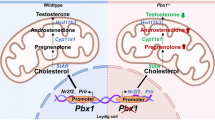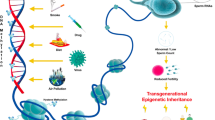Abstract
Aneuploidy, which leads to unpaired chromosomal axes during meiosis, is frequently accompanied by infertility. We previously showed, using three mouse models of Down syndrome, that it is an extra chromosome, but not extra gene dose, that is associated with male infertility and virtual absence of post-meiotic gem cells. Here, we test the hypothesis that aneuploid segments are differentially modified and expressed during meiosis, depending on whether they are present as an extra chromosome or not. In all three models examined, the trisomic region lacks a pairing partner, but in one case, spermatocytes have an extra (and unpaired) chromosome, while the two other models involve translocation of the trisomic region rather than an extra chromosome. An extra unpaired chromosome was always modified by phosphorylation of histone H2AX and lacked RNA PolII. But in the case of trisomic regions attached to a paired chromosome, assembly of these protein modifications was affected by the position of a trisomic region relative to a centromere and the physical extent of the unpaired chromatin. Analysis of gene expression in testes revealed that extra copy number alone was not sufficient for meiotic upregulation of genes in the trisomic interval. Additionally and unexpectedly, presence of meiotic gene silencing chromatin modifications was not sufficient for downregulation of genes in unpaired trisomic chromatin. Thus, the meiotic chromatin modifications that are cytologically visible are unlikely to be directly involved in sterility versus fertility of DS models. Finally, the presence of an extra unpaired chromosome, but not the presence of extra (trisomic) genes, caused global deregulation of transcription in spermatocytes. These results reveal mechanisms by which an extra chromosome, but not trisomic gene dose, impact on meiotic progress and infertility.






Similar content being viewed by others
References
Baarends WM, Wassenaar E, van der Laan R, Hoogerbrugge J, Sleddens-Linkels E, Hoeijmakers JH, de Boer P, Grootegoed JA (2005) Silencing of unpaired chromatin and histone H2A ubiquitination in mammalian meiosis. Mol Cell Biol 25:1041–1053
Barlow AL, Benson FE, West SC, Hulten MA (1997) Distribution of the RAD51 recombinase in human and mouse spermatocytes. EMBO J 16:5207–5215
Bustin SA (2002) Quantification of mRNA using real-time reverse transcription PCR (RT-PCR): trends and problems. J Mol Endocrinol 29:23–39
Cheng Z, Tu C, Rodriguez L, Chen TH, Dvorak MM, Margeta M, Gassmann M, Bettler B, Shoback D, Chang W (2007) Type B gamma-aminobutyric acid receptors modulate the function of the extracellular Ca2+-sensing receptor and cell differentiation in murine growth plate chondrocytes. Endocrinology 148:4984–4992
Cui X, Hwang JT, Qiu J, Blades NJ, Churchill GA (2005) Improved statistical tests for differential gene expression by shrinking variance components estimates. Biostatistics 6:59–75
Davisson M, Akeson E, Schmidt C, Harris B, Farley J, Handel MA (2007) Impact of trisomy on fertility and meiosis in male mice. Hum Reprod 22:468–476
Davisson MT, Schmidt C, Reeves RH, Irving NG, Akeson EC, Harris BS, Bronson RT (1993) Segmental trisomy as a mouse model for down syndrome. Prog Clin Biol Res 384:117–133
de Boer P, de Jong J (1980) Chromosome pairing and fertility in mice. CRC, Boca Raton
Dennis G Jr, Sherman BT, Hosack DA, Yang J, Gao W, Lane HC, Lempicki RA (2003) DAVID: database for annotation, visualization, and integrated discovery. Genome Biol 4:P3
Ferguson KA, Chow V, Ma S (2008) Silencing of unpaired meiotic chromosomes and altered recombination patterns in an azoospermic carrier of a t(8;13) reciprocal translocation. Hum Reprod 23:988–995
Fernandez-Capetillo O, Mahadevaiah SK, Celeste A, Romanienko PJ, Camerini-Otero RD, Bonner WM, Manova K, Burgoyne P, Nussenzweig A (2003) H2AX is required for chromatin remodeling and inactivation of sex chromosomes in male mouse meiosis. Dev Cell 4:497–508
Garagna S, Zuccotti M, Thornhill A, Fernandez-Donoso R, Berrios S, Capanna E, Redi CA (2001) Alteration of nuclear architecture in male germ cells of chromosomally derived subfertile mice. J Cell Sci 114:4429–4434
Homolka D, Ivanek R, Capkova J, Jansa P, Forejt J (2007) Chromosomal rearrangement interferes with meiotic X chromosome inactivation. Genome Res 17:1431–1437
Huang TT, Yasunami M, Carlson EJ, Gillespie AM, Reaume AG, Hoffman EK, Chan PH, Scott RW, Epstein CJ (1997) Superoxide-mediated cytotoxicity in superoxide dismutase-deficient fetal fibroblasts. Arch Biochem Biophys 344:424–432
Kahlem P, Sultan M, Herwig R, Steinfath M, Balzereit D, Eppens B, Saran NG, Pletcher MT, South ST, Stetten G, Lehrach H, Reeves RH, Yaspo ML (2004) Transcript level alterations reflect gene dosage effects across multiple tissues in a mouse model of down syndrome. Genome Res 14:1258–1267
Kent WJ (2002) Blat—the blast-like alignment tool. Genome Res 12:656–664
La Salle S, Trasler JM (2006) Dynamic expression of DNMT3a and DNMT3b isoforms during male germ cell development in the mouse. Dev Biol 296:71–82
Liu DP, Schmidt C, Billings T, Davisson MT (2003) Quantitative PCR genotyping assay for the Ts65Dn mouse model of Down syndrome. Biotechniques 35:1170–1174
Lyle R, Gehrig C, Neergaard-Henrichsen C, Deutsch S, Antonarakis SE (2004) Gene expression from the aneuploid chromosome in a trisomy mouse model of Down syndrome. Genome Res 14:1268–1274
Mahadevaiah SK, Bourc'his D, de Rooij DG, Bestor TH, Turner JM, Burgoyne PS (2008) Extensive meiotic asynapsis in mice antagonises meiotic silencing of unsynapsed chromatin and consequently disrupts meiotic sex chromosome inactivation. J Cell Biol 182:263–276
O'Doherty A, Ruf S, Mulligan C, Hildreth V, Errington ML, Cooke S, Sesay A, Modino S, Vanes L, Hernandez D, Linehan JM, Sharpe PT, Brandner S, Bliss TV, Henderson DJ, Nizetic D, Tybulewicz VL, Fisher EM (2005) An aneuploid mouse strain carrying human chromosome 21 with Down syndrome phenotypes. Science 309:2033–2037
Peters AH, Plug AW, de Boer P (1997a) Meiosis in carriers of heteromorphic bivalents: sex differences and implications for male fertility. Chromosome Res 5:313–324
Peters AH, Plug AW, van Vugt MJ, de Boer P (1997b) A drying-down technique for the spreading of mammalian meiocytes from the male and female germline. Chromosome Res 5:66–68
Prandini P, Deutsch S, Lyle R, Gagnebin M, Delucinge Vivier C, Delorenzi M, Gehrig C, Descombes P, Sherman S, Dagna Bricarelli F, Baldo C, Novelli A, Dallapiccola B, Antonarakis SE (2007) Natural gene-expression variation in Down syndrome modulates the outcome of gene-dosage imbalance. Am J Hum Genet 81:252–263
Reeves RH, Irving NG, Moran TH, Wohn A, Kitt C, Sisodia SS, Schmidt C, Bronson RT, Davisson MT (1995) A mouse model for Down syndrome exhibits learning and behaviour deficits. Nat Genet 11:177–184
Reinholdt L, Ashley T, Schimenti J, Shima N (2004) Forward genetic screens for meiotic and mitotic recombination-defective mutants in mice. Methods Mol Biol 262:87–107
Rogers RS, Inselman A, Handel MA, Matunis MJ (2004) SUMO modified proteins localize to the XY body of pachytene spermatocytes. Chromosoma 113:233–243
Sago H, Carlson EJ, Smith DJ, Kilbridge J, Rubin EM, Mobley WC, Epstein CJ, Huang TT (1998) Ts1Cje, a partial trisomy 16 mouse model for Down syndrome, exhibits learning and behavioral abnormalities. Proc Natl Acad Sci U S A 95:6256–6261
Schimenti J (2005) Synapsis or silence. Nat Genet 37:11–13
Sciurano R, Rahn M, Rey-Valzacchi G, Solari AJ (2007) The asynaptic chromatin in spermatocytes of translocation carriers contains the histone variant gamma-H2AX and associates with the XY body. Hum Reprod 22:142–150
Shiu PK, Raju NB, Zickler D, Metzenberg RL (2001) Meiotic silencing by unpaired DNA. Cell 107:905–916
Smirnova NA, Romanienko PJ, Khil PP, Camerini-Otero RD (2006) Gene expression profiles of Spo11-/- mouse testes with spermatocytes arrested in meiotic prophase I. Reproduction 132:67–77
Storey J (2002) A direct approach to false discovery rates. J R Stat Soc, Ser B 64:479–498
Torres EM, Williams BR, Amon A (2008) Aneuploidy: cells losing their balance. Genetics 179:737–746
Torres EM, Sokolsky T, Tucker CM, Chan LY, Boselli M, Dunham MJ, Amon A (2007) Effects of aneuploidy on cellular physiology and cell division in haploid yeast. Science 317:916–924
Turner JM, Mahadevaiah SK, Fernandez-Capetillo O, Nussenzweig A, Xu X, Deng CX, Burgoyne PS (2005) Silencing of unsynapsed meiotic chromosomes in the mouse. Nat Genet 37:41–47
Turner JM, Aprelikova O, Xu X, Wang R, Kim S, Chandramouli GV, Barrett JC, Burgoyne PS, Deng CX (2004) BRCA1, histone H2AX phosphorylation, and male meiotic sex chromosome inactivation. Curr Biol 14:2135–2142
van der Heijden GW, Derijck AA, Posfai E, Giele M, Pelczar P, Ramos L, Wansink DG, van der Vlag J, Peters AH, de Boer P (2007) Chromosome-wide nucleosome replacement and H3.3 incorporation during mammalian meiotic sex chromosome inactivation. Nat Genet 39:251–258
Villar AJ, Belichenko PV, Gillespie AM, Kozy HM, Mobley WC, Epstein CJ (2005) Identification and characterization of a new Down syndrome model, Ts[Rb(12.1716)]2Cje, resulting from a spontaneous Robertsonian fusion between T(1716)65Dn and mouse chromosome 12. Mamm Genome 16:79–90
Yang H, Churchill G (2007) Estimating p-values in small microarray experiments. Bioinformatics 23:38–43
Acknowledgments
We are grateful to Drs. David Bergstrom, Muriel Davisson, Sophie La Salle, and two anonymous reviewers for thoughtful comments on the manuscript, and we appreciate Dr. Sophie La Salle for providing technical advice and protocols for quantitative RT-PCR. We also thank the Gene Expression and Computational Biology services at The Jackson Laboratory for their excellent technical assistance. This work was supported by a grant from the NIH to MAH (HD48998), a Cancer Center Core Grant to The Jackson Laboratory (CA34196) and a contract supporting the Cytogenetic Models Resource at The Jackson Laboratory (N01-HD73265).
Author information
Authors and Affiliations
Corresponding author
Additional information
Communicated by E.A. Nigg
Electronic supplementary material
Below is the link to the electronic supplementary material.
Supplemental Fig 1.
Genes that were significantly (q < 0.1) differentially expressed by 1.5-fold or more in enriched spermatocyte preparations from a) 16 to 17 dpp, Ts65Dn testes and b) 19 to 20 dpp, Ts65Dn testes compared to that of wild-type diploid (WT) littermates (DOC 3193 kb)
Supplemental Fig 2.
Expression of App in wild-type, diploid (WT) and Ts65Dn in enriched spermatocyte preparations from 16 to 17 and 19 to 20 dpp testes. Normalized expression values are represented as means from triplicate samples from a representative biological replicate. Mean ± SD (n = 3 experimental replicates). Bars within a panel marked with the same letter represent expression values that are not significantly different, while those marked with different letters are different represent expression values that are significantly different (p < 0.05)
Rights and permissions
About this article
Cite this article
Reinholdt, L.G., Czechanski, A., Kamdar, S. et al. Meiotic behavior of aneuploid chromatin in mouse models of Down syndrome. Chromosoma 118, 723–736 (2009). https://doi.org/10.1007/s00412-009-0230-8
Received:
Revised:
Accepted:
Published:
Issue Date:
DOI: https://doi.org/10.1007/s00412-009-0230-8




